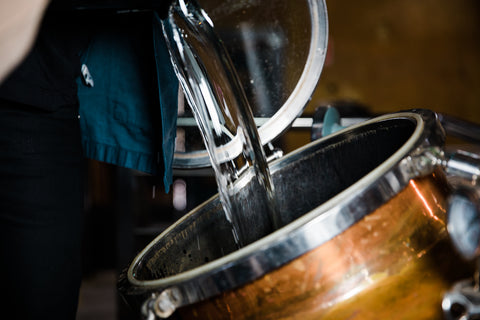A brief history on Eau De Vie
From 14th Century France to our very own creation made from Australian grapes, we trace the origins of this storied spirit—and look to its modern reimagining in 2021 and beyond.
What is an eau de vie? Is it a new spirit or an old one? Is it technically a brandy? What kinds of fruits are they generally made from?
Since launching our own grape-based eau de vie earlier this year, we’ve been blown away at the curiosity of Australian drinkers and their willingness to learn more about the history—and future—of this immersive spirit that drinks like velvet over ice.
You’ve all seen it in recent years: the meteoric rise of craft gin, tequila, whisky and even mezcal. From Sydney to London and Texas, small batch distillers from every corner of the globe have been reviving techniques, sometimes hundreds of years old, to bring old spirits into the 21st Century. What about eau de vie? In many ways, you could say it’s one of the final frontiers in this space.
It’s also one of the oldest commercial spirits in existence, and in our opinion, one of the most exciting. There’s a bit to unpack. But it’s a conversation we could have till the bar closes and the lights come on. So, pull up a stool. Fill your glass with Rouse, Revel, Vivify or Bask if you’ve got some nearby for the story of this otherworldly, fruit-based creation.
First, let’s rewind: what exactly is an eau de vie?
An eau de vie de fruits is essentially a clear, colourless brandy distilled from fruit. Consider its translation from French to “water of life from fruit,” and you begin to get a sense of the importance to its spiritual home, with many European countries also having a version of their own. Think Italy’s grape-based grappa, the Balkan’s rakia (grapes, plums, apricots or pears), German schnapps (apples, cherries, pears or plums) and even Sri Lanka’s coconut arrack.


What does it taste and feel like?
We’ve said it once and we’ll say it again: eau de vie, especially those made from grapes, is among the softest, most velvety spirits we’ve ever tried. The art of making this spirit all comes down to distilling the essence of the base fruit in its purest form. In our own creations, layered beneath the botanicals of Rouse, Vivify, Bask and Revel, there’s a touch of grape that comes out to meet you, it almost whispers wine. See if you can sense it next time you take a sip.


Tracing it all the way back to 14th Century France
We’re in Gascony, France, sometime in the 1400s. Armagnac, a brandy made from grapes, is said to have been traded in the region’s Saint Lever market, and from there went on to become one of France’s most renowned exports, still with us to this day. It is, in fact, one of the oldest commercial spirits in the world.


Arriving at the spirited future of Australian grapes
How did Feels Botanical arrive at eau de vie, over a grain-based creation? And why Australian grapes over, say, apples or plums? Our co-creator Blake first glimpsed the potential of grape-based eau de vie during his years working for global spirit brands. (Our other, Steve, saw its gluten-free value). Once experiencing the velvety, creamy mouthfeel and lingering fruity wine notes, that was it—he knew that one day he’d have to go out and explore it on his own. For us, harnessing Australian grapes to make a spirit was a no-brainer. Our wine industry is one of the best in the world. The wines themselves are coveted from China to Europe and America.


It must be said, in recent years, local spirit brands have pioneered incredible products in this space. Take Archie Rose’s eau de vie brandy made from the smoke-tainted grapes of 2019’s catastrophic bushfire season. As well as Four Pillars Gin, who have found cult success with their Bloody Gin Shiraz by steeping Yarra Valley grapes in their base distillation. 

For us, a spirit made from grapes over grain is at the heart of what we do—and that journey has only just begun. While it took months fine-tuning the technical components, and layering three sustainably-sourced botanicals to achieve perfect balance, it ultimately came back to what each creation made us feel. And it’s that spirit we hope you take with you each time you sit down with us, glass full.
